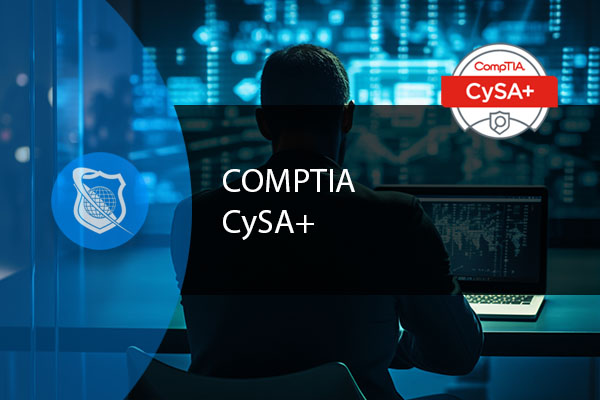What is a Group Policy Object (GPO)?
Definition: Group Policy Object (GPO) A Group Policy Object (GPO) is a set of rules and settings within Microsoft Active Directory that control the working environment of user accounts and

Safeguarding the endpoints of your network is paramount and endpoint security tools and toolsets play a critical role in identifying and mitigating malicious activities, ensuring the integrity and confidentiality of your data. This blog delves into the common tools for detecting malicious activity, covering packet capture, log analysis, endpoint security, DNS tools, file analysis, and sandboxing. These are essential areas of focus for anyone preparing for the CYSA exam or looking to bolster their network security.

Ready to fortify digital landscapes? Unleash your potential with our CySA+ course. Master behavioral analytics, shield networks, and become a certified defender against cyber threats. Elevate your security prowess, ace the CompTIA CySA+ (CS0-003) exam, and secure a resilient future for organizations
Packet capture tools, such as TCPdump, are fundamental in monitoring network traffic. They allow cybersecurity professionals to inspect the details of the traffic on a network, identifying anomalies such as unexpected IP addresses, dubious domain names, or potentially malicious packets. Whether deployed on Linux, Linux servers, or Windows, packet capture tools are indispensable for a detailed network traffic analysis.
Packet capture tools are essential for network diagnostics and security analysis, allowing professionals to monitor and analyze network traffic in real time or from recorded sessions. Here’s a detailed look at some of the most widely used packet capture tools, covering their names, advantages, disadvantages, vendors, ease of use, and pricing.

Propel your career forward and be part of an essential member of any management team as an Information Security Manager. This advanced training series is designed specifically for those want to move up into a management position in the IT field.
Each of these tools offers unique capabilities and trade-offs, catering to different needs and expertise levels. While free, open-source options like Wireshark, TCPdump, and Tshark are highly popular for their robust features and flexibility, they may require a learning curve to master fully. Tools like Moloch cater to enterprise needs, offering scalable solutions for large-scale packet capture and analysis. Selecting the right tool often depends on the specific requirements of the task, including the scale of packet capture needed, the user’s familiarity with command-line interfaces, and the need for real-time versus post-hoc analysis.
Log analysis tools, including Security Information and Event Management (SIEM) tools, Security Orchestration, Automation, and Response (SOAR) systems, and Intrusion Detection Systems/Intrusion Prevention Systems (IDS/IPS), are crucial for analyzing log files and managing data. These tools help in detecting, preventing, and responding to security incidents by analyzing vast amounts of log data to identify patterns of malicious activity.
Log analysis tools are crucial for cybersecurity and network administration, providing insights into system performance, security incidents, and operational trends. These tools help in parsing, aggregating, and analyzing log data from various sources. Below is a detailed exploration of some key log analysis tools, including their features, pros and cons, vendors, ease of use, and whether they are free or paid.
Selecting the right log analysis tool depends on several factors, including the specific needs of the business, the volume of data to be analyzed, the technical expertise of the users, and budget constraints. Open-source solutions like the ELK Stack and Graylog offer flexibility and customization at the cost of a potentially steeper learning curve and the need for more hands-on maintenance. In contrast, commercial products like Splunk and LogRhythm provide comprehensive, out-of-the-box solutions with support and advanced features, albeit at a higher cost.

An Information Security Analyst plays a pivotal role in safeguarding an organization’s digital infrastructure and sensitive data. This job involves a blend of technical expertise, vigilance, and continuous learning to protect against ever-evolving cyber threats.
In today’s enterprise environments, securing endpoints—be it servers, desktops, laptops, or mobile devices—is non-negotiable. Endpoint security solutions, such as Microsoft Defender, CrowdStrike Falcon, Trend Micro, and SentinelOne, offer comprehensive protection against threats. They manage the security of devices across the enterprise, safeguarding against malware and other cyber threats.
Endpoint security tools are essential for protecting the devices that connect to your network, such as laptops, desktops, smartphones, and servers, from cyber threats. These tools help in detecting, preventing, and responding to malware and other security threats. Below, we explore some of the key endpoint security tools, detailing their features, pros and cons, vendors, ease of use, and pricing information.
When selecting an endpoint security solution, it’s essential to consider the specific needs of your organization, including the types of devices to be protected, your IT team’s expertise, and your budget. Free solutions or those included with existing software licenses can provide basic protection, but advanced threats often require the more sophisticated analysis and defense mechanisms found in paid products. Each tool listed offers unique advantages and potential drawbacks, underscoring the importance of evaluating them in the context of your organization’s security posture and operational requirements.

View our comprehensive training series covering all the key elements and certifications needed to successfully excel in an IT User Support Specialist job role.
DNS tools like WHOIS and AbuseIPDB are essential for domain research and identifying problematic domains. WHOIS services, now managed directly by ICANN, provide details on domain ownership and registration, helping validate the legitimacy of internet sites. AbuseIPDB, on the other hand, aids in identifying domains associated with spam, hacking, and other malicious activities.
DNS tools play a crucial role in internet security and administration by helping organizations monitor and manage domain name system activities. These tools can provide valuable insights into domain registrations, configurations, and potential security threats. Here’s a closer look at some key DNS tools, highlighting their features, advantages, disadvantages, vendors, ease of use, and whether they are free or paid.
These DNS tools offer a range of functionalities from basic domain lookup services to advanced DNS security and management features. The choice of tool depends on the specific needs, such as whether the focus is on enhancing security, improving DNS management, or conducting domain research and troubleshooting. Free tools can provide valuable insights and services for individuals and small businesses, while paid services offer enhanced capabilities suitable for larger organizations with more complex DNS needs.
File analysis tools are designed to scrutinize files for integrity and authenticity. Tools like Strings and VirusTotal, along with file analyzers, help determine whether a file has been tampered with or if it poses any security risk. These tools are vital for identifying malicious files within file systems, contributing to the overall security posture.
Our robust CompTIA Sec+ course is the perfect resouce to ensure your company’s most valuable assets are safe. Up your security skills with this comprehensive course at an exceptional price.
File analysis tools are essential for cybersecurity professionals, IT administrators, and anyone needing to inspect the integrity, authenticity, and security of files. These tools help identify potentially malicious files, verify file changes, and ensure compliance with security policies. Here’s an exploration of some key file analysis tools, including their features, advantages, disadvantages, vendors, ease of use, and pricing.
Selecting the right file analysis tool depends on the specific requirements of the task at hand, including the types of files being analyzed, the depth of analysis needed, and the technical expertise of the user. Tools like VirusTotal and Hybrid Analysis offer quick, comprehensive scans using multiple engines and are user-friendly, making them suitable for a broad audience. In contrast, tools like PEiD, FileAlyzer, and Cuckoo Sandbox provide more specialized functionalities and deeper analysis capabilities, catering to more technical users or specific investigative needs.
Sandboxing is a best practice for containing potential malicious events. Tools like Joe Sandbox and Cuckoo Sandbox offer environments to safely execute and analyze suspicious code without risking the main network or systems. By isolating the threat, sandboxing allows for secure testing and analysis of malware behavior.
Sandboxing tools are critical for enhancing cybersecurity by isolating and analyzing suspicious code, files, or applications in a secure environment. This isolation prevents potentially harmful software from affecting the host system or network. Here’s a detailed look at some of the key sandboxing tools, highlighting their features, pros and cons, vendors, ease of use, and pricing.
Sandboxing tools are vital for security testing, malware analysis, and safe execution of untrusted programs. The choice of tool depends on your specific needs, such as the level of analysis required, the operating systems in use, and your budget. While open-source tools like Cuckoo Sandbox and Sandboxie offer great flexibility and no cost, commercial products like Joe Sandbox and FireEye Helix provide more comprehensive analysis capabilities and support, albeit at a higher price. Tools like VMware Workstation and VMware Fusion, although not exclusively designed for sandboxing, offer a versatile environment for testing and analysis.
Knowing the key terms related to Endpoint Security Tools is vital for anyone looking to secure their network endpoints effectively. These terms encompass technologies, strategies, and tools used to prevent, detect, and manage cybersecurity threats targeting endpoint devices. Familiarity with these terms can significantly enhance one’s ability to understand and implement endpoint security measures.
| Term | Definition |
|---|---|
| Endpoint Security | The approach and practices for securing endpoints or entry points of end-user devices such as desktops, laptops, and mobile devices from being exploited by malicious actors and campaigns. |
| Packet Capture | The act of capturing data packets across a computer network. Used in network troubleshooting and analysis, as well as cybersecurity investigations to monitor and identify potential threats. |
| TCPdump | A powerful command-line packet analyzer used for network diagnostics and cybersecurity purposes. |
| Wireshark | A network protocol analyzer that lets you see what’s happening on your network at a microscopic level, widely used for network troubleshooting, analysis, and software and protocol development. |
| Tshark | The command-line version of Wireshark, used for capturing and analyzing packets without a graphical interface. |
| Pcapng | A file format for storing network packet data, used by Wireshark and other network analysis tools. |
| Moloch | An open-source, large scale, full packet capturing, indexing, and database system. |
| Log Analysis | The process of examining log files to identify patterns, detect anomalies, and extract information related to cybersecurity and network health. |
| SIEM (Security Information and Event Management) | Software that provides real-time analysis of security alerts generated by applications and network hardware. |
| SOAR (Security Orchestration, Automation, and Response) | Technologies that enable organizations to collect inputs monitored by the security operations team. |
| IDS/IPS (Intrusion Detection System/Intrusion Prevention System) | Network security technologies that examine network traffic flow to detect and prevent vulnerability exploits. |
| Splunk | A software platform to search, analyze, and visualize the machine-generated data gathered from the websites, applications, sensors, devices, etc. |
| ELK Stack (Elasticsearch, Logstash, Kibana) | An open-source collection of three tools that work together to provide insights into your data from any source, in any format. |
| Graylog | An open-source log management tool that allows searching and analyzing logs across your network using a web interface. |
| LogRhythm | A security information and event management (SIEM) solution that combines log management, machine learning, big data analytics, and forensics to provide threat detection and response. |
| SolarWinds Log & Event Manager | A security information and event management (SIEM) tool designed to simplify the process of collecting, storing, analyzing, and managing computer security logs. |
| Microsoft Defender for Endpoint | An enterprise endpoint security platform designed to help enterprise networks prevent, detect, investigate, and respond to advanced threats. |
| CrowdStrike Falcon | A cloud-delivered endpoint protection solution that offers next-generation antivirus, endpoint detection and response (EDR), and a managed hunting service powered by AI. |
| Trend Micro Apex One | An endpoint security solution providing automated threat detection and response against an ever-growing variety of threats, including fileless and ransomware. |
| SentinelOne | An autonomous AI endpoint security solution that prevents, detects, responds, and hunts in the context of all enterprise assets. |
| Sophos Intercept X | An endpoint protection software that uses deep learning to block known and unknown malware, ransomware, and exploits. |
| DNS Tools | Tools used for querying the Domain Name System (DNS) to obtain domain name or IP address mapping or for any other specific DNS record. |
| WHOIS | A query and response protocol that is widely used for querying databases that store the registered users or assignees of an internet resource, such as a domain name, an IP address block, or an autonomous system. |
| AbuseIPDB | A database that helps to track and report IP addresses that engage in abuse such as spam, hacking, and other malicious activities. |
This comprehensive list encompasses a variety of tools, technologies, and practices that are fundamental to understanding and implementing endpoint security solutions effectively.
As we navigate through the complexities of cybersecurity, understanding and utilizing the right tools and toolsets for endpoint security is crucial. From monitoring network traffic with packet capture tools to analyzing files for malicious content and sandboxing potential threats, each tool serves a unique purpose in the overarching goal of protecting your network. As we move forward, let’s equip ourselves with the knowledge and tools necessary to defend against the ever-evolving landscape of cyber threats.
Endpoint security tools are software applications designed to protect devices like computers, mobile phones, and servers (collectively known as endpoints) from malicious activities, cyber threats, and unauthorized access. These tools can include antivirus programs, firewalls, intrusion detection systems (IDS), and more advanced solutions like endpoint detection and response (EDR) platforms. They work by monitoring, detecting, and responding to threats to ensure the safety and integrity of endpoint devices and the networks they connect to.
While antivirus software primarily focuses on detecting and removing malware from a device, endpoint security tools offer a broader range of protections. Besides malware protection, endpoint security can include firewall management, intrusion detection, and response, data encryption, and device management capabilities. Essentially, while antivirus is a critical component of endpoint security, the latter encompasses a wider set of security measures designed to address a comprehensive range of cyber threats.
Endpoint security is crucial because endpoints are often the target of initial attacks. Cyber attackers exploit vulnerabilities in endpoint devices to gain access to networks, steal data, or deploy malware. With the increase in remote work and the use of personal devices for business purposes (BYOD – Bring Your Own Device policies), securing these endpoints becomes even more critical to protect sensitive information and maintain the integrity of organizational networks.
Free endpoint security tools can offer basic protection and may be suitable for individuals or very small businesses with limited budgets. However, for organizations with more complex needs or those handling sensitive information, paid solutions typically provide more comprehensive protection, advanced features, and customer support. It’s important to assess your specific security requirements and consider whether a free tool meets those needs or if a paid solution is a more prudent investment for long-term security.
When choosing an endpoint security tool, consider the following factors:
Comprehensive Protection: Look for tools that offer a wide range of security features beyond just antivirus, such as firewall management, intrusion prevention, and data encryption.
Performance Impact: Ensure the tool does not significantly slow down the device or impact user productivity.
Ease of Use and Management: The tool should be user-friendly and offer centralized management for administering policies and monitoring security across all endpoints.
Scalability: Choose a solution that can grow with your organization, accommodating more users and devices as
needed.
Compatibility: Ensure the tool is compatible with the operating systems and other software used within your organization.
Lorem ipsum dolor sit amet, consectetur adipiscing elit. Ut elit tellus, luctus nec ullamcorper mattis, pulvinar dapibus leo.
$49.99 Original price was: $49.99.$16.99Current price is: $16.99. / month with a 10-day free trial
Definition: Group Policy Object (GPO) A Group Policy Object (GPO) is a set of rules and settings within Microsoft Active Directory that control the working environment of user accounts and
Definition: Multisource Feedback Multisource feedback, also known as 360-degree feedback, is a performance appraisal system where employees receive confidential, anonymous feedback from the people who work around them. This typically
Definition: Python BeautifulSoup BeautifulSoup is a Python library used for parsing HTML and XML documents. It creates a parse tree from page source code that can be used to extract
Definition: Extensible Authentication Protocol (EAP) Extensible Authentication Protocol (EAP) is a flexible authentication framework widely used in wireless networks and point-to-point connections. It provides a standard mechanism for support of
Definition: IT Maturity Model The IT Maturity Model is a framework that assesses the maturity and capability of an organization’s IT processes and systems. This model provides a structured approach
Definition: Twitter Bootstrap Twitter Bootstrap, commonly referred to as Bootstrap, is a free, open-source front-end framework for developing responsive and mobile-first websites. It provides a collection of CSS and JavaScript
Definition: Visual Studio Code Visual Studio Code (often abbreviated as VS Code) is a source-code editor developed by Microsoft. It is available for Windows, macOS, and Linux and includes support
Definition: Hashing Algorithm A hashing algorithm is a mathematical function that converts an input (or ‘message’) into a fixed-size string of bytes, typically a digest that appears random. The output,
Definition: Binary Binary is a number system that uses only two symbols, typically 0 and 1. It is the foundational language of computers and digital systems, representing and processing data
Definition: Fiber To The X (FTTx) Fiber To The X (FTTx) refers to a series of broadband network architectures that use optical fiber to replace all or part of the
Definition: Mouseover Mouseover is a term used in web development and user interface design to describe an event that occurs when a user moves their mouse cursor over a particular
Definition: Management Console A Management Console is a software interface that provides administrators with a centralized platform to monitor, configure, and manage various IT resources and systems within an organization.
ENDING THIS WEEKEND: Train for LIFE at our lowest price. Buy once and never have to pay for IT Training Again.